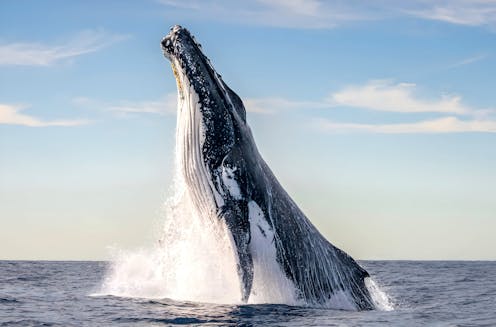Whales sing when they’ve had a good meal – new research
- Written by The Conversation

Spanning more octaves than a piano, humpback whales sing powerfully into the vast ocean. These songs are beautifully complex, weaving phrases and themes into masterful compositions. Blue and fin whales richly fill out a bass section with their own unique versions of song.
Together, these three species can create a marvellous symphony in the sea.
Published today in PLOS One, our new research reveals these baleen whale species’ response to major changes in their ecosystem can be heard in their songs.
Food for long-distance travel
The six-year study took place in whale foraging habitat in the eastern North Pacific, off the coast of California in the United States. From this biologically rich foraging habitat, the whales migrate long distances each year to breeding habitats at lower latitudes.
They eat little to nothing during their migration and winter breeding season. So they need to build up their energy stores during their annual residence in foraging habitat.
This energy, stored in their gigantic bodies, powers the animals through months of long-distance travel, mating, calving, and nursing before they return to waters off California in the spring and summer to resume foraging.
The whales eat krill and fish that can aggregate in massive schools. However, their diets are distinct.
While blue whales only eat krill, humpback whales eat krill and small schooling fish such as anchovy. If the prey species are more abundant and more densely concentrated, whales can forage more efficiently. Foraging conditions and prey availability change dramatically from year to year.
We wanted to know if these changes in the ecosystem were reflected in the whales’ acoustic behaviour.
Piecing together a complex puzzle
To track the occurrence of singing, we examined audio recordings acquired through the Monterey Accelerated Research System. This is a deep-sea observatory operated by the Monterey Bay Aquarium Research Institute and funded by the US National Science Foundation.
Analysis of sound recordings is a highly effective way to study whales because we can hear them from quite far away. If a whale sings anywhere within thousands of square kilometres around the hydrophone, we will hear it.
Yet, piecing together the complex puzzle of whale behavioural ecology requires diverse research methods.
Our study used observations of the whales, including sound recordings, photo identification and diet analysis. It also used measurements of forage species abundance, characterisation of ecosystem conditions and theoretical modelling of sound propagation.
Our ability to probe the complex lives of these giants was enhanced for humpback whales because we had a unique data resource available for this species: extensive photo identification.
The Happywhale community science project combines photos supplied by researchers and ecotourists, and identification enabled by artificial intelligence, to recognise individual whales by the shape and coloration of their flukes.
This unique resource enabled us to examine the local abundance of humpback whales. We could also study the timing of their annual migration and how persistently individual whales occupied the study region.
An increase in food – and in song
The study began in 2015, during a prolonged marine heatwave that caused major disruption in the foraging habitat of whales and other animals throughout the eastern North Pacific.
All three whale species sang the least during the heatwave, and sang more as foraging conditions improved over the next two years.
These patterns provided the first indications that the singing behaviour by whales may be closely related to the food available. Remarkably, whale song is an indicator of forage availability.
Further evidence was found in the striking differences between humpback and blue whales during the later years of the study.
Continued increases in detection of humpback whale song could not be explained by changes in the local abundance of whales, the timing of their annual migration, or the persistence of individuals in the study region.
However, humpback song occurrence closely tracked tremendous increases in the abundances of northern anchovy — the largest increase in 50 years. And when we analysed the skin of the humpback whales, we saw a clear shift to a fish-dominated diet.
In contrast, blue whales only eat krill, and detection of their songs plummeted with large decreases in krill abundance. Our analysis of blue whale skin revealed they were foraging over a larger geographic area to find the food they needed during these hard times in the food web.
Predicting long-term changes
This research shows listening to whales is much more than a rich sensory experience. It’s a window into their lives, their vulnerability, and their resilience.
Humpback whales emerge from this study as a particularly resilient species. They are more able to readily adapt to changes in the ecology of the foraging habitats that sustain them. These findings can help scientists and resource managers predict how marine ecosystems and species will respond to long-term changes driven by both natural cycles and human impacts.
At a time of unprecedented change for marine life and ecosystems, collaboration across disciplines and institutions will be crucial for understanding our changing ocean.
This work was enabled by private research centres, universities and federal agencies working together. This consortium’s past work has revealed a rich new understanding of the ocean soundscape, answering fundamental questions about the ecology of ocean giants.
Who knows what more we will learn as we listen to the ocean’s underwater symphony?
This work was led by John Ryan, a biological oceanographer at the Monterey Bay Aquarium Research Institute (MBARI), with an interdisciplinary team of researchers from MBARI, Southern Cross University, Happywhale.com, Cascadia Research Collective, University of Wisconsin, NOAA Southwest Fisheries Science Centre, University of California, Santa Cruz, Naval Postgraduate School, and Stanford University.
Read more https://theconversation.com/whales-sing-when-theyve-had-a-good-meal-new-research-250926







